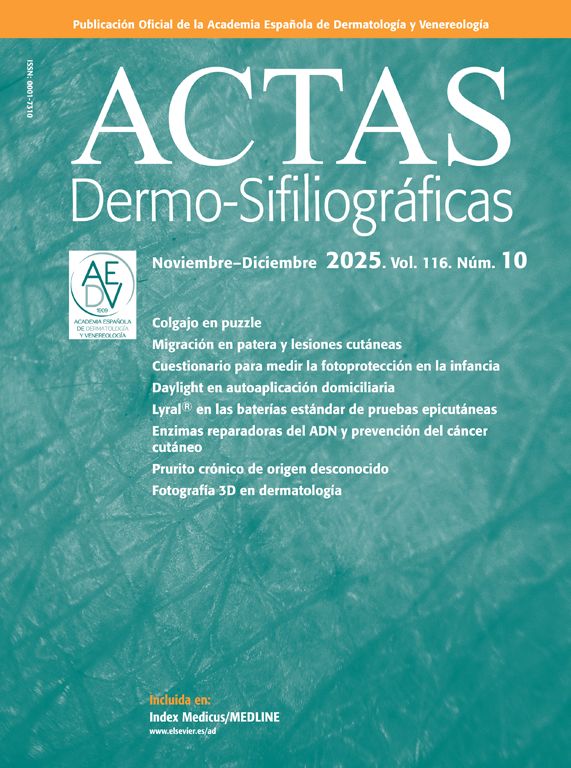Bullous pemphigoid (BP) is an autoimmune skin disease that generally affects elderly individuals. Traditional treatment with systemic corticosteroids and immunosuppressants is associated with multiple adverse effects, complicating therapeutic adherence in this age group, where associated comorbidities are a common finding. Dupilumab has recently emerged as an effective treatment for refractory BP, with a superior safety profile compared to traditional alternatives.
We conducted a retrospective descriptive observational study, including all cases of BP treated with dupilumab at our hospital from October 2019 to October 2023.
A total of 8 patients were included (Table 1). The median age at diagnosis was 78.5 years [65.75–85.5]. Notable personal medical histories included diabetes mellitus (62.5%), hypertension (50%), dyslipidemia (50%), kidney failure (37.5%), rheumatoid arthritis (12.5%), and locally advanced cutaneous squamous cell carcinoma of the hand, not eligible for surgery or radiotherapy (12.5%). In 5 patients (62.5%), a triggering drug was identified: gliptins (37.5%), GLP-1 analogs (12.5%), and anti-PD1 agents (12.5%). Regarding previous treatments, the most common were systemic and topical corticosteroids (100%), doxycycline (100%), nicotinamide (100%), methotrexate (62.5%), IV immunoglobulins (12.5%), and azathioprine (12.5%). The usual dosing regimen of dupilumab was 300mg every 2 weeks. All patients achieved complete remission after a median of 44 days [41.75–56.5] from the start of dupilumab. In 3 patients (37.5%), the dosing regimen was optimized to 300mg every 4 weeks due to good clinical control, maintaining the response. In 2 patients (25%), the drug was discontinued due to absence of lesions, without relapse after a median follow-up of 134.5 [81.75–187.25] days. No adverse effects were reported in our study.
Results of a monocentric study with dupilumab in bullous pemphigoid.
| n (%) or value | |
|---|---|
| Sex | |
| Women | 4 (50) |
| Men | 4 (50) |
| Age at diagnosis (years), median [range] | 78.5 [65.75–85.5] |
| Comorbidities | |
| Diabetes mellitus | 4 (50) |
| Dyslipidemia | 5 (62.5) |
| HTN | 4 (50) |
| Kidney failure | 3 (37.5) |
| Rheumatoid arthritis | 1 (12.5) |
| Irresectable LA-CSCC | 1 (12.5) |
| Triggers | |
| Unknown | 3 (37.5) |
| Gliptins | 3 (37.5) |
| GLP-1 analogs | 1 (12.5) |
| Anti-PD-1 | 1 (12.5) |
| Previous treatments | |
| Systemic corticosteroids (IV/oral) | 8 (100) |
| Topical corticosteroids | 8 (100) |
| Doxycycline | 8 (100) |
| Nicotinamide | 8 (100) |
| Methotrexate | 5 (62.5) |
| IVIG | 1 (12.5) |
| Azathioprine | 1 (12.5) |
| Time from BP diagnosis to start of dupilumab (months), median [range] | 5.5 [2–11] |
| Initial dose 600mg | 6 (75) |
| Time to complete remission (days), median [range] | 44 [41.75–56.5] |
| Optimization to 300mg/4 weeks | 3 (37.5) |
| Treatment discontinuation | 2 (25) |
| Time in complete remission after discontinuation (days), median [range] | 134.5 [81.75–187.25] |
| Adverse events | (0) |
LA-CSCC: locally advanced cutaneous squamous cell carcinoma; GLP-1: glucagon-like peptide-1; HTN: hypertension; IVIG: intravenous immunoglobulins; BP: bullous pemphigoid.
BP is one of the most common autoimmune blistering diseases. It is characterized by the formation of subepidermal blisters following the binding of circulating autoantibodies against BP180 or BP230 antigens present in the dermoepidermal basement membrane. BP typically affects patients older than 70 years (the median age in our series was 78.5 years).1 Numerous drugs have been associated with the development of BP, with oral antidiabetics of the gliptin group being the most frequent, as in our case. Recently, an increase in BP associated with immunotherapy using PD-1 or PDL-1 inhibitors has been described, used in dermatology for the treatment of advanced cutaneous cancer.2 In our series, one case triggered by cemiplimab (anti-PD-1) was reported, prescribed for a locally advanced cutaneous squamous cell carcinoma on the dorsum of the hand, not eligible for surgery or radiotherapy, with good control after the initiation of dupilumab, without requiring discontinuation of immunotherapy. Currently, the main treatment options are based on the nonspecific suppression of inflammation, with topical and systemic corticosteroids being the first-line therapy. Their use can be limited by comorbidities such as diabetes mellitus, which is highly prevalent among the elderly (present in 50% of patients in our series).3 In refractory cases, classic immunosuppressants such as methotrexate are prescribed, whose use must be adjusted according to renal function, increasing the incidence rate of kidney failure in this age group (observed in 37.5% of our patients).4 Recently, an increase in proinflammatory Th2 cytokines such as IL-4, IL-5, IL-13, and IL-31 has been reported in the pathogenesis of BP, which can recruit eosinophils, other inflammatory cells, and promote IgE secretion.5 Additionally, cytokines like IL-4 and IL-31 can sensitize peripheral nerves, causing pruritus. Dupilumab is a monoclonal antibody directed against the IL-4 receptor alpha subunit, inhibiting IL-4 and IL-13 signaling, thereby blocking the inflammatory response, thus reducing pruritus, and preventing disease progression.6 The usual dupilumab dosing regimen is 300mg every 2 weeks, with an optional initial dose of 600mg. In our study, 75% of patients received 600mg initially, followed by 300mg every 2 weeks, with the treatment optimized to 300mg every 4 weeks in 37.5% of cases, maintaining clinical response. It was discontinued in 25% of patients due to the absence of lesions, with complete remission persisting to date after a median follow-up of 134.5 days. Currently, dupilumab is not approved for the treatment of BP, but it appears to be a promising alternative with a strong safety and efficacy profile.7–9
Conflicts of interestNone declared.




